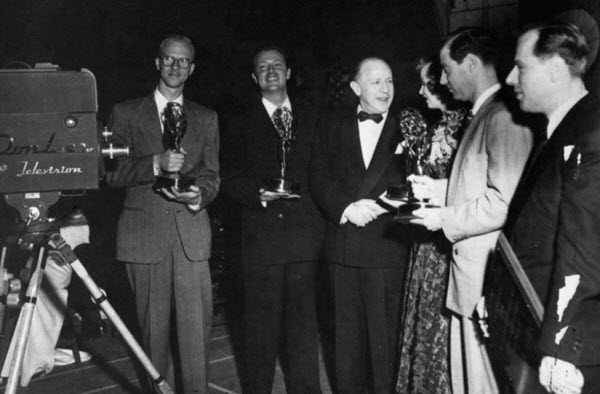If the Oscars are dedicated to recognizing cinematic excellence, the Emmy Awards are the equivalent for television. Known for its broad range of accolades, the Emmy Awards celebrate artistic and technical achievements in the television industry across the United States and globally. Held annually, the awards ceremony presents winners with a statue of a winged woman holding an atom. This prestigious award is one of the four major annual American entertainment awards, alongside the Grammy Awards for music, the Oscars for film, and the Tony Awards for theater. The Emmys are presented by three interconnected yet separate organizations: the Academy of Television Arts & Sciences (ATAS), the National Academy of Television Arts & Sciences (NATAS), and the International Academy of Television Arts & Sciences (IATAS). Each organization manages a specific set of Emmy ceremonies.
History of the Emmy Awards

The Academy of Television Arts & Sciences (ATAS), based in Los Angeles, established the Emmy Awards as a part of its promotional efforts. The first Emmy Awards ceremony was held on January 25, 1949, at the Hollywood Athletic Club, initially honoring only local productions in the Los Angeles area. Actress Shirley Dinsdale received the first Emmy for Best Television Personality during this inaugural event. The award was named “Emmy,” a play on the French colloquial term “Immy,” which referred to a type of camera tube used in early television cameras. Throughout the 1950s, ATAS expanded the Emmys into a national event, recognizing shows broadcast across the country. In 1955, the National Academy of Television Arts & Sciences (NATAS) was formed in New York to serve members on the East Coast, while ATAS continued to host a separate event for local Los Angeles productions. NATAS established branches across the U.S., each developing its local Emmy ceremony.
Initially, there was only one annual Emmy event to honor nationally broadcast shows in the U.S. However, in 1974, a subsidiary ceremony called the “Daytime Emmys” was established to recognize achievements in daytime television programming. The International Emmy Awards were also created in the early 1970s to honor television programs initially produced and broadcast outside the U.S. In 1977, ATAS and NATAS severed ties due to various disputes but agreed to share ownership of the Emmy statue and trademark. Each academy continued to manage specific award categories, except for engineering awards, which each academy awards independently.
The Emmy Statue

The Emmy statue, designed by television engineer Louis McManus, depicts a winged woman holding an atom. McManus used his wife as the model for the statue. ATAS rejected 47 design proposals before settling on McManus’s design in 1948. Since then, the small statue has become a symbol of excellence in television arts and sciences, with the wings representing artistic inspiration and the atom symbolizing scientific achievement.
When naming the award, ATAS founder Sid Cassidy suggested “Ike,” a nickname for the image tube used in early television cameras and also a reference to WWII hero and future U.S. President Dwight D. Eisenhower. However, members of the academy wanted a unique name. Television engineer and third ATAS president Harry Lubcke proposed the name “Emmy,” a term used for the image tube, which was later feminized to “Emmy” to match the statue’s female figure.
The weight and dimensions of the Emmy statue vary by event. The Primetime Emmy statues weigh 3.08 kg and are made of brass, nickel, silver, and gold. They stand 39 cm tall with a 19 cm base and weigh 2.5 kg. The Regional Emmy statues are 29 cm tall with a 14 cm base and weigh 1.4 kg. Each statue takes about five and a half hours to produce and is handled with white gloves to avoid fingerprints. The statues were made in Chicago by the same company that produced the Oscars until 2016, when production moved to New York.
Types of Awards

The various Emmy competitions occur annually, ranging from national television shows to locally and regionally produced programs. Each event has its own set of award categories, nomination, and voting procedures. Generally, a show is considered national if it reaches more than 50% of American households; shows that do not meet this criterion are eligible for Regional Emmys. Regardless of the specific competition, winners are all referred to as “Emmy winners.” The Emmy ceremonies are divided into the following categories:
Primetime
The Primetime Emmy Awards recognize excellence in American television programming during prime time. The ceremony is typically held in mid-September, on the Sunday before the official start of the fall television season. It is currently broadcast alternately on ABC, CBS, NBC, and Fox. Some categories, such as those for behind-the-scenes work (e.g., set design, costume design, cinematography, sound design), are awarded separately at a Creative Arts Emmys ceremony. Voting for the Primetime Emmys occurs in June to determine nominees and in August for final winners.
Daytime
The Daytime Emmy Awards are presented annually in May or June, honoring excellence in daytime television programming. The first Daytime Emmys were awarded in 1972, but the first dedicated ceremony did not occur until 1974. Like the Primetime Emmys, a separate event is held shortly before to honor behind-the-scenes contributors in daytime television. Voting is conducted by NATAS members.
Sports
The Sports Emmy Awards, presented by NATAS, recognize excellence in sports programming. The ceremony typically takes place each spring, often during the last two weeks of April or the first week of May, on a Monday night in New York City. Voting is conducted by panels of judges with expertise in national sports production. Companies like Paramount Global, Disney, NBCUniversal, Fox Corporation, Warner Bros., and Discovery have one representative each. Most categories have a single round of voting, with the top five entries announced as nominations before the winner is announced.
News and Documentary
The News and Documentary Emmy Awards, presented by NATAS, recognize excellence in national news and documentary programming. The ceremony is held each fall, with voting by panels of judges with experience in news or documentary production. Most categories have two rounds of voting, with nominees announced before the final winner is determined.
Children’s and Family
On November 17, 2021, NATAS announced it would begin presenting the Children’s and Family Emmys starting in 2022. These awards will recognize excellence in children’s and family television programming. Previously, most children’s and family programming categories fell under the Daytime Emmys, while prime time broadcasts were included in the Primetime Emmys. NATAS cited the substantial growth in children’s and family programming in recent years as the reason for this new ceremony.

Engineering
The Primetime Engineering Emmy is presented by ATAS, while the Technology & Engineering Emmy is awarded by NATAS. These are separate competitions honoring individuals, companies, or organizations for significant developments and contributions in television’s engineering and technological aspects. The Technology & Engineering Emmys are typically held in January, while the Primetime Engineering Emmys are awarded in October. Each academy has its own team of highly qualified engineers to determine the award recipients.
Regional
There are 20 regional branches across the U.S., each presenting Regional Emmys to recognize excellence in regional television, local news, and locally produced shows. NATAS oversees 19 regional branches, while ATAS manages one branch based in Los Angeles, serving only that area. Regional Emmys help NATAS and ATAS honor deserving local television work. Each region has its own nomination and voting procedures, with review committees assessing eligibility and meeting standards before final votes are counted by certified accounting firms.
International
The International Emmy Awards honor excellence in television programming initially produced outside the U.S. They have been presented annually by IATAS since 1973. The ceremony is generally held in November in New York City. Any non-U.S. organization or individual, such as a network, local or regional TV station, producer, director, or writer, can submit a program for consideration, regardless of IATAS membership. Joint productions between U.S. and foreign companies are eligible if initially broadcast outside the U.S. or if their air dates are close together. Programs entered in the International Emmys cannot also be entered in local competitions.
Student
College Television Awards are presented by ATAS to recognize excellence in student-produced work. College students across the country can submit their work in categories like comedy, documentary, drama, music, news, and series. Submissions are first judged by ATAS members specializing in each category before winners are selected. Each entry must include a faculty advisor’s signed form verifying it was produced as part of a school project. Similarly, NATAS presents National Student Production Awards for high school students’ work, recognizing excellence in news, craft, and programming.
Governors and Trustees
The Governors Award is the highest honor given by ATAS, recognizing an individual, company, or organization for significant achievements. The Trustees Award is the highest honor given by NATAS, recognizing extraordinary or enduring achievements by an individual.
Humanitarian and Public Service
The Bob Hope Humanitarian Award is presented by the ATAS Board of Governors to an individual in the industry whose humanitarian work has a lasting impact on the community. The Emmy Award for Public Service is dedicated to public service announcements and programming aimed at “promoting the public good.”
